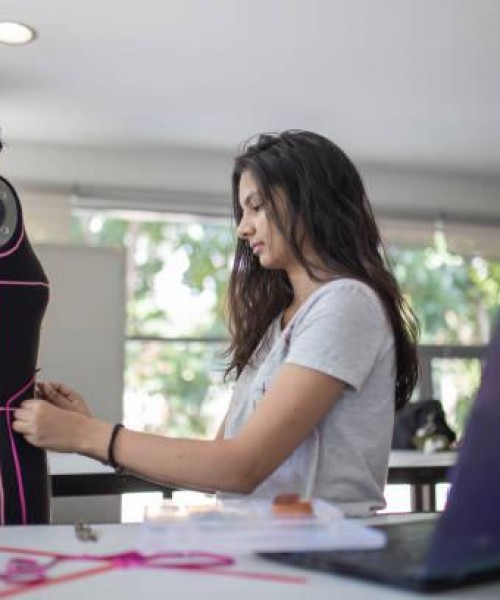Initially, classification was done in matlab ,by finding the respiration rate of the signal. Depending upon the respiration rate, the signal was classified as normal, bradypnea or tachypnea, but it was not helpful in finding whether the signal belongs to central sleep apnea or obstructive sleep apnea. The signal is plotted for a time period of 1 minute with a sampling frequency of 1Hz. For normal breathing, there should be 1 breath cycle per 5 sec. As there will be a negative peak due to expiration, the entire signal is normalized by squaring to convert the negative peaks into positive peaks. For each 5 sec the sample with amplitude is plotted and the remaining samples are marked as zero. Then the samples with amplitude greater than 12volts are marked as 1 and the other samples as zero. Now the respiration rate is calculated by the number of samples at 1. If the respiration rate is less than 10, the condition is bradypnea. If the respiration rate is greater than 20, the condition is tachypnea. If the respiration rate is between these two conditions, it is normal.
The normal respiration data plotted for 60 samples and the signal is normalized by squaring the amplitude values, thereby changing the negative values into positive values.
The plot of respiratory cycles for a minute and it is counted as one normal cycle if the peak amplitude exceeds 12V while all other peaks or suppressed to find the normal respiratory rate.
4.1.6 Results Of Classification Of Apnea In Labview
As the OSA and CSA were not classified in Matlab, it was classified using LabVIEW based on the results of statistical parameter calculation. The mean for a normal respiratory signal is 0.0V with a standard deviation of 0.2V and for an apnea signal is 0.25V with standard deviation of 0.01V. The peak-to-peak voltage changes distinctly between obstructive sleep apnea and central sleep apnea. With these changes in mean and peak-to-peak voltage the signal were classified into normal, apnea, obstructive sleep apnea and central sleep apnea. Once the signals were classified, the respective LED will glow. The results obtained from these LEDs were shown in the following figures.
Signal classified as Normal with the mean of 0.0074 and the peak-to-peak voltage of 7.915 and the corresponding LED glows is shown in Figure 4.8 .
The signal classified as an Apnea signal and further as Central Sleep Apnea with the mean of 0.29742 and peak-to-peak voltage of 4.361V and the corresponding LEDs glow. Figure 4.10 shows the signal classified as apnea and further classified as obstructive sleep apnea with the mean of 0.33443 and peak-to-peak voltage of 2.196 and corresponding LEDs glow.
4.1.7 Performance Evaluation
After classification of the signals into normal, central sleep apnea and obstructive sleep apnea ,the accuracy of the apnea classifier was checked and the following results were found.
Total number of input data=40
Number of True Positives, TP =17
Number of True Negatives, TN=18
Number of False Positives, FP=2
Number of False Negatives, FN=3
Accuracy is the measure of degree of closeness to the true value. Sensitivity is the proportion of sick people diagnosed as sick and Specificity is the proportion of healthy people diagnosed as healthy.
Accuracy, Sensitivity and Specificity can be calculated using the following formula.
Sensitivity = (TP / TP+FN) x 100
Specificity = (TN / TN+FP) x 100
Accuracy = (TP+TN / TN+TP+FP+FN) x 100
The results were found to be,
ACCURACY=87.5%
SENSITIVITY=85%
SPECIFICITY=90%
CHAPTER 5
5.1 CONCLUSION
Impedance Pneumographic technique was used for acquiring the respiratory signal. The circuit was designed and tried in Multisim. The excitation source produced the expected output of 50kHz signal and the constant current source designed for 4mA current produced a current of 2.8mA which is less. When soldered, a 50kHz signal was produced with 10Vpp from the excitation circuit and the current source did not produce any constant current. Also, due to ethical issues, the idea of applying current to the human body was dropped and the types of apnea were classified with the offline data.
Respiratory data were collected from the databases for 40 patients. Each data was plotted and classified as normal or bradypnea or tachypnea based on the respiration rate using Matlab. With the same data, the statistical parameters such as mean, range(peak-to-peak voltage), standard deviation for each data were calculated and the results were analyzed. On analyzing, it was found out that change in the mean and peak-to-peak voltage were prominent for the normal and apnea signal and types apnea such as OSA and CSA. Thus, a LabVIEW design for the classification of apnea is provided based on these two parameters. This method gave an accuracy of 87.5%.
This work can be very helpful for the physicians in identifying the type of apnea and to give treatment for that particular type. If the apnea is OSA, treatment should be given to the respiratory pathway and if its CSA, treatment should be given to the nervous system.
5.2 FUTURE WORK
- To simulate the respiratory signal using a phantom of thoracic impedance.
- To classify real time acquired signals
- To correlate EEG with apnea condition and analyze its changes.
REFERENCES
JOURNALS
- Adrián Poblano,Aída MárquezandGuadalupe Hernández 2006 “Apneain infants” Indian Journal of Pediatrics,Volume 73,Pages 228-229.
- M.D.Bruce Jenkinsand M.D.Henry G. Herrod 1984, “Apnea monitor-related hypertension”, The Journal of Pediatrics, Volume 105, Pages 333-334.
- T. Douglas Bradley, Alexander G. Logan,, R. John Kimoff, , Frédéric Sériès, Debra Morrison, Kathleen Ferguson, Israel Belenkie, 2005“Continuous Positive Airway Pressure for Central Sleep Apnea and Heart Failure”, The New England Journal of Medicine, Volume 353:2035-2033,Pages 123-128
- H. Klar Yaggi, M.D., M.P.H., John Concato, M.D., M.P.H., Walter N. Kernan, M.D., Judith H. Lichtman, Ph.D., M.P.H., Lawrence M. Brass, M.D., and Vahid Mohsenin, M.D. 2005, “Obstructive Sleep Apnea as a Risk Factor for Stroke and Death”, The New England Journal of Medicine, Volume 353:2034-2041, Pages 675-681.
- Marcel A. Baltzanand Norman Wolkove, 2000 “Persistent sleep apnea is common and needs to be found”, Journal of Sleep Medicine Volume 11, Pages 115-116.
- Patricia Bromberger,Hector E. James,Brian SaundersandHoward Schneider 1988 “Sudden infantapneaand insidious hydrocephalus” Child's Nervous System,Volume 4,Pages 345-346.
- M. Ramagopal,A. Mehta,D. W. Roberts,J. S. Wolf,R. J. Taylor, K. E. Mudd,S. M. Scharf. 2009 “Asthma as a Predictor of Obstructive Sleep Apnea in Urban African-American Children”Journal of Asthma46:9, Pages 895-899.
- SoniaAncoli-Israel,Daniel F.Kripke,WilliamMason 1987 “Characteristics of Obstructive and Central Sleep Apnea in the Elderly: An Interim Report”, Journal of the Society of Biological Psychiatry,Volume 22,Pages 741-750.
BOOKS
- Gary W. Johnson, Richard Jennings, “LabVIEW Graphical programming” ,McGraw Hill, Fourth edition,2006.
- Khandpur R.S, “Handbook of Biomedical Instrumentation”, Tata McGraw-Hill, Third edition,1997.
- Robert L.Boylestad Louis Nashesky , “Electronic Devices and Circuit Theory” Rourson Education Asia, Second edition, 2002.
URLS
- www.physionet.org/physiotools
- www.healthmad.com/Types of breathing
- ist.com/Respiratory measurements
LIST OF PUBLICATIONS
V.Kanimozhi , A.Then Aruna , SP.Vijayalakshmi and DR..V.Mahesh ,“Design and Development of an Apnea Detector and Classification of Apnea” Submitted to International Conference on Information Processing (ICIP),Bangalore,on April 5 , 2010.









